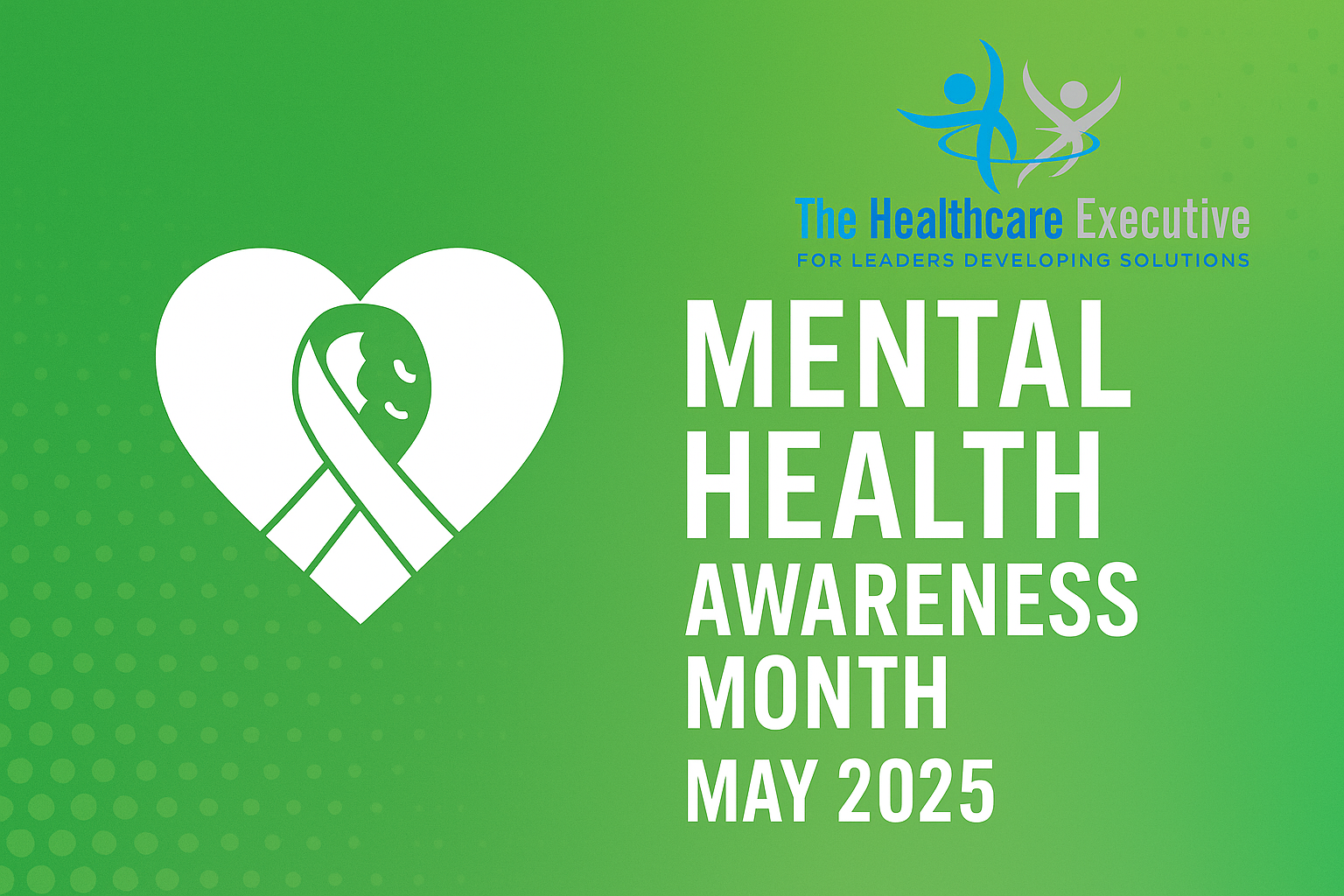Mental Health Awareness Month – May 2025

- Posted by Greg Wahlstrom, MBA, HCM
- Posted in Health Observance Calendar
Hospital Leadership Strategies for Advancing Mental Wellbeing
Published: May 2, 2025
Each May, Mental Health Awareness Month challenges healthcare leaders to prioritize psychological safety as a strategic imperative, not just a wellness campaign. In a sector where burnout and compassion fatigue are at historic highs, mental health infrastructure must be built into hospital operations. According to NIMH data, nearly one in five U.S. adults lives with a mental illness—a reality that extends across all levels of the hospital workforce. Executive teams must lead the charge by de-stigmatizing mental health conversations, normalizing help-seeking behaviors, and embedding supportive services into the employee lifecycle. Investments in behavioral health must go beyond insurance offerings and include practical, accessible support mechanisms. EAP programs, peer counseling, and clinical mental health services should be integrated, measurable, and tailored to the intensity of care delivery environments. Hospital boards must track utilization and outcomes—not just offer programs as a checkbox. Leaders who model vulnerability and open dialogue can transform culture from the top down. As Mayo Clinic research shows, psychologically safe work environments foster innovation, trust, and patient safety. Mental Health Awareness Month is an invitation to design those environments with purpose and urgency.
The healthcare workforce crisis cannot be solved without addressing mental wellbeing systemically. Employee engagement and retention are inextricably linked to how supported workers feel emotionally. Leaders must move from reactive burnout mitigation to proactive mental fitness development. Initiatives like mindfulness programs, resilience training, and trauma-informed leadership workshops must be executive-endorsed and evaluated for impact. At Mass General’s Center for Work and Well-Being, clinical staff receive structured support for coping with the unique stressors of care delivery. This model should serve as a blueprint for health systems seeking to institutionalize wellbeing. Hospital administrators must allocate budget and leadership bandwidth to mental health just as they do for infection control or patient throughput. CFOs should recognize that the ROI on mental health programs includes lower turnover, reduced absenteeism, and higher performance. Real-time data dashboards can help monitor organizational pulse and flag at-risk teams. Leadership training must include modules on emotional intelligence and crisis de-escalation to build a culture of psychological safety. This May, let every hospital CEO evaluate whether their workforce sees mental health as a priority—or just a poster on a wall.
Mental health challenges impact not only staff but also patients, caregivers, and community members navigating hospital systems under duress. Executives have a responsibility to ensure behavioral health integration across the continuum of care. Screening tools for depression, anxiety, and substance use should be embedded into routine intake and discharge processes. At Rush University Medical Center, collaborative care teams are breaking silos between psychiatry, primary care, and emergency services. This approach streamlines access to mental health care and reflects the reality that behavioral health is not separate from physical health. Boards and C-Suites should incentivize cross-departmental collaboration to eliminate fragmentation. Care pathways must account for trauma history, social determinants of health, and linguistic accessibility. A truly patient-centered system considers mental health at every touchpoint—not just during crisis. Hospital systems that do this well build reputational trust, improve outcomes, and reduce re-hospitalizations. Telebehavioral health and digital triage tools offer additional scale, especially in rural or underserved regions. Mental Health Awareness Month is a reminder that healing must include the mind as well as the body.
Leadership visibility matters more than ever during Mental Health Awareness Month. Executives who participate in wellness walks, town halls, and storytelling initiatives send a message that mental health is not a hidden issue—it’s a leadership priority. Some systems have implemented “mental health rounding,” where leaders engage staff directly in open conversations about stress, coping, and support needs. These moments build relational trust and signal cultural change. The Johns Hopkins Bayview Medical Center developed a model for peer responder teams trained in psychological first aid, which executives can replicate at scale. Additionally, HR and DEI leaders must ensure that mental health support is culturally responsive and trauma-informed. This includes offering materials in multiple languages and aligning services with employee backgrounds and lived experiences. Leadership cannot afford to ignore the racial and generational disparities in access to mental health care. Transparent measurement—through surveys, focus groups, and exit interviews—can identify gaps and inform equity-based adjustments. The more mental health becomes embedded into performance dashboards, the more normalized and resourced it becomes. May 2025 should be the turning point where hospital leadership commits to authentic, visible engagement with mental health strategy.
May is not just a month for raising awareness—it is a time to act with intention. Mental Health Awareness Month must be treated as a springboard for year-round transformation across every level of the healthcare enterprise. Executives must ask hard questions: Is mental health part of our strategic plan? Do our policies reflect our values? Are our teams resilient, or merely surviving? Hospital boards should align with community-based mental health partners to build referral pipelines and reduce ED boarding. CIOs and CMOs should evaluate digital tools for anonymous feedback, stress monitoring, and crisis support. CHROs must embed mental health training into onboarding, leadership development, and compliance frameworks. C-suite performance evaluations should include metrics on wellbeing, engagement, and workforce stability. Future-forward leadership doesn’t wait for a crisis to address mental health—it builds systems that prevent one. As Mental Health Awareness Month unfolds, let this be a defining moment for governance, culture, and courage. The most trusted health systems will be those that prioritize people—starting with their minds.
Discover More: Explore strategic tools to transform mental health culture across your organization with our latest thought leadership.
Related Posts from The Healthcare Executive
- The Healthcare Workforce Crisis: Executive Solutions That Actually Work
- Rebuilding Trust in U.S. Healthcare: A Leadership Blueprint



